Robert Deutsch | Jul 11, 2017
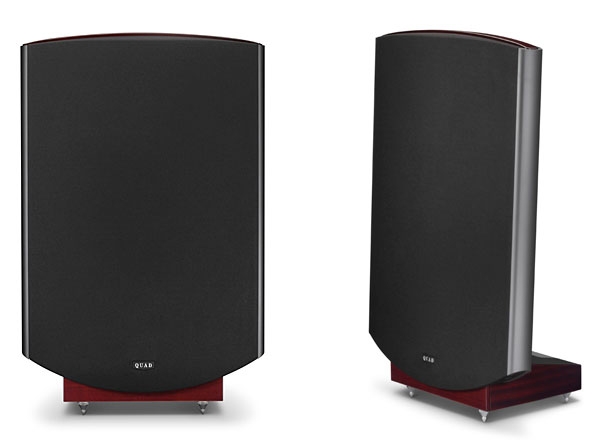
If Stereophile gave an award for Loudspeaker We’ve Most Frequently Reviewed, the hands-down winner would have to be the Quad ESL. The list of past and present Stereophile contributors who’ve written about the ESL’s various incarnations includes John Atkinson, Martin Colloms, Anthony H. Cordesman, Art Dudley, Larry Greenhill, J. Gordon Holt, Ken Kessler, Dick Olsher, Herb Reichert, William Sommerwerck, Steven Stone, and Sam Tellig. The ESL-63 was John Atkinson’s personal “Editor’s Choice” in 1992, and the ESL-989, a successor to the ESL-63, was Stereophile‘s 2003 Loudspeaker of the Year and Product of the Year.
As acclaimed as it was for its sound, the ESL-63 also acquired a reputation for unreliability. Quad has had spotty distribution in the US, and for several years had no US distribution at all. That situation changed in 2016, when MoFi Distribution became the North American importer for the entire Quad line. They set up a dealer network, and established a service center that will service all versions of the Quad ESL—going back to the original ESL of 1957 (footnote 1). According to Jonathan Derda, MoFi’s national sales and marketing manager, the facility has a technician specifically trained to deal with ESLs, and a good supply of parts. MoFi Distribution is a going concern that distributes products for Balanced Audio Technology, IsoTek, Koetsu, Little Fwend (yes, the nifty automatic tonearm lift), Solidsteel, Spiral Groove, TAD, Dr. Feickert, and Wharfedale, as well as their eponymous record label devoted to ultra-high-quality reissues, Mobile Fidelity Sound Lab.
Memory Lane
My first electrostatic loudspeaker was the KLH Model Nine, which J. Gordon Holt once called “the most nearly perfect loudspeaker we have ever heard.” Indeed, it was a very fine speaker—when it worked, which was considerably less than 100% of the time. I came to dread the intermittent buzz that meant that the tweeter was arcing and would soon need to be replaced. Worse still, the speaker’s transformer was sealed in wax, and when that malfunctioned it had to be shipped to Boston to be repaired by the technician who specialized in the Nine. (KLH had by then changed hands and no longer officially supported the model.) After the third time this happened (and the problem had been fixed), I was fed up, and decided to sell my Nines while they were still working.
But I wasn’t quite ready to abandon electrostatics, and in the early 1980s I read with considerable interest about the then-new Quad ESL-63. I tried a pair and was impressed with their imaging, but thought the bass too mushy, and the speaker generally not as crisp-sounding as a (properly functioning) KLH Nine. I then had a chance to try a pair of used but recent-production original ESLs. I preferred these to the ESL-63s, and the price was right. I bought the ESLs, and they proved to be reliable as well as excellent-sounding over several years of ownership. But they didn’t go very low or play very loud, and I eventually sold them and moved on to various speakers that were more conventional and proved to be easier to live with.
Throughout all of this, I retained a fondness for electrostatic speakers, and made a point of seeking them out at audio events. When, at the 2016 Consumer Electronics Show, I discovered that Quad was once again being distributed in North America, with a new top model that promised to remedy the weaknesses of the ESL-63, I decided to check it out.
Design
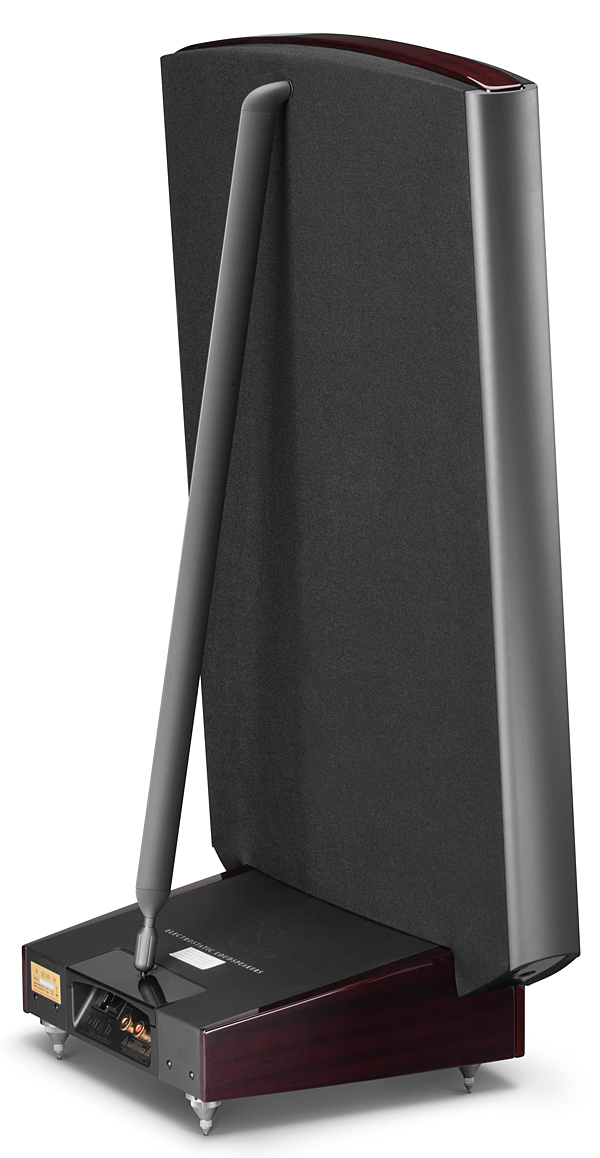 I’ll assume that anyone reading this review is familiar with the basic operating principles of electrostatic loudspeakers—to quote the ever-useful Wikipedia, “a loudspeaker design in which sound is generated by the force exerted on a membrane suspended in an electrostatic field.” Quad designer Peter Walker’s most important innovation in the ESL-63 was to design the electrostatic stators—stationary conductive elements that carry the amplified music signal—as a set of concentric circles, the signal arriving just a bit later at the next circle outward than it had at the one inside it, the resulting total sound simulating that of a point source. Unlike the ESL, which had damping material behind the rear stators to attenuate the diaphragm’s rearward radiation, the ESL-63 was allowed to function as a dipole: soundwaves radiated from front and rear, with no significant attenuation of the backwave.
I’ll assume that anyone reading this review is familiar with the basic operating principles of electrostatic loudspeakers—to quote the ever-useful Wikipedia, “a loudspeaker design in which sound is generated by the force exerted on a membrane suspended in an electrostatic field.” Quad designer Peter Walker’s most important innovation in the ESL-63 was to design the electrostatic stators—stationary conductive elements that carry the amplified music signal—as a set of concentric circles, the signal arriving just a bit later at the next circle outward than it had at the one inside it, the resulting total sound simulating that of a point source. Unlike the ESL, which had damping material behind the rear stators to attenuate the diaphragm’s rearward radiation, the ESL-63 was allowed to function as a dipole: soundwaves radiated from front and rear, with no significant attenuation of the backwave.
Although the ESL-63 (and, before it, the ESL) had been well received by audiophiles, many felt it could be improved by judicious modifications. The easiest and simplest modification involved stands that elevated the speaker and stiffened its frame, the best known of which was the Arcici stand (footnote 2). (Sadly, Arcici and its founder, Ray Shab, are no longer with us.) Removing or lowering the speaker’s cloth “sock” has been widely regarded as effective in improving its transparency—and producing a singularly ugly loudspeaker. The most radical modification of the ESL-63—by Alistair Robertson-Aikman, founder of SME—was described in Ken Kessler’s excellent book, Quad: The Closest Approach. The mod dispensed with the sock, metal grille, and Mylar dustcover, without which—as Robertson-Aikman warns in the chapter he wrote for Kessler’s book—”there is high risk of electric shock which can continue for some time after the unit is switched off.” The structural modifications included transverse brass beams weighing some 70 lbs and a metal frame, the effective weight of the entire assembly further increased by a 100-lb billet of steel attached to the top of each speaker. Elements of the Robertson-Aikman mod can be seen in the current ESL-2912 ($13,999/pair).
Over the years, Quad has changed hands several times. It is now owned by the International Audio Group (IAG), based in Shenzen, China. IAG promised to remain true to Peter Walker’s original concept, but also made changes intended to improve weaknesses in the performance of the ESL-63. They also promised to improve the speaker’s reliability, which has continued to be a problem throughout the ESL-63’s 36 years of production. Since 2013, all Quad ESL models have been made in China; my impression—based on talking to owners and people in the industry—is that, following some teething problems, the reliability of the made-in-China ESLs is greatly improved.
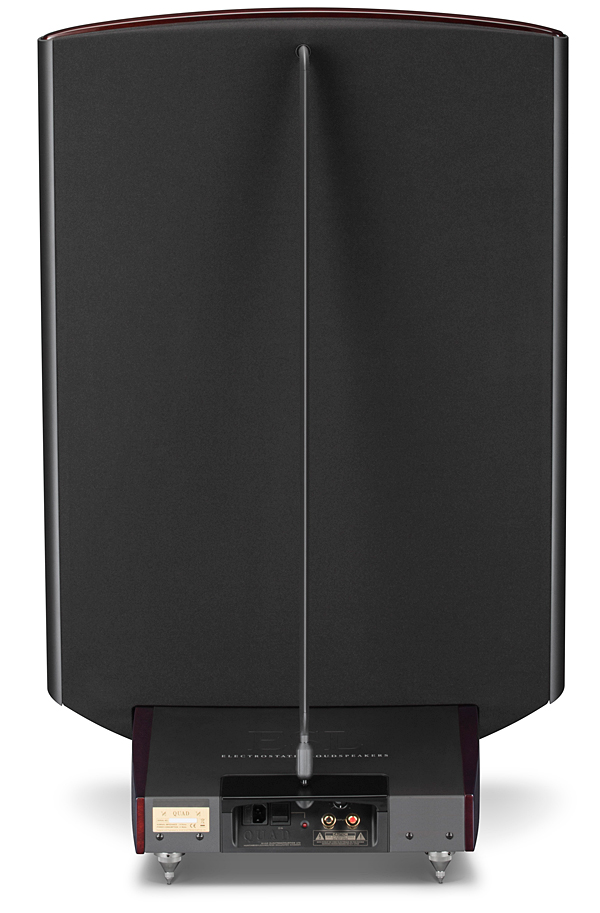
Under IAG ownership, in 2000 Quad came out with a new sort of speaker that had often been suggested as a way of improving the ESL-63: a taller ESL with the same footprint as the ESL-63, but not so tall as to be unacceptable in the typical living room. This was the ESL-989, reviewed by Larry Greenhill in November 2002, and in May 2003 by Art Dudley and John Atkinson. The current incarnation of this design is the ESL-2912. The ESL-63 had two woofer panels; in the ESL-989 these were joined by two additional woofer panels, one each on top and bottom—and so it is in the new ESL-2912. The additional woofer panels receive the same (delayed) signal as the standard ones. (Quad’s current lineup also includes the ESL-2812, which has only two woofer panels; it’s essentially the same size as the ESL-63, but incorporates the manufacturing improvements present in the ESL-2912.)
What are the advantages of a taller speaker? There is, first of all, a higher soundstage, which many people prefer, as do I. The elevation of the midrange-tweeter panel also results in less interference from floor bounce, a problem with the ESL-63, noted by some reviewers. But the most important benefits expected from a taller ESL would be in the bass and in maximum output capability. In an e-mail, Peter Comeau, director of acoustic design for Quad and its IAG sister brands Audiolab, Castle, Mission, and Wharfedale, told me that there’s a common misconception that the 2912 has “bigger” bass because the extra bass panels add more “power” to the low frequencies. He pointed out that the original papers by Peter Walker and Peter Baxandall showed, in “the Walker equation,” that the speaker’s maximum SPL is related to or dependent on its height, while its low-frequency extension is related to the size of its panel. “Thus, the extra bass panels provide improved extension at low frequencies whilst the increased height improves the maximum SPL capability of the ESL-2912 (as it approaches the line source at LF),” Comeau wrote.
Other improvements in the 2912 and 2812 over previous ESLs include: 1) a more acoustically transparent grillecloth/sock; 2) physical separation of the power-supply and audio circuits; 3) revised PCB traces, to ensure stability of the power supply; 4) a low-ESR bypass capacitor in the audio circuit; 5) improved, gold-plated speaker terminals; and 6) matching, piano-lacquered, veneered panes on top of the speaker and on the sides of the base, formed from high-density plywood to further damp frame resonances. (For full discussion of all of the changes made since the introduction of the ESL-63, see the reviews referenced above.) The quality of the fit and finish of the ESL-2912 represents a major improvement over the ESL and ESL-63.
Setup
Any speaker can benefit from expert setup, and this is especially so for panel speakers, for which the distance from the front wall and the degree of toe-in are particularly critical. Although I have some experience with panel speakers—in addition to owning the KLH Nines and the ESLs, in the September 2012 issue I reviewed MartinLogan’s Montis, a hybrid speaker with an electrostatic panel—I welcomed the setup expertise offered by MoFi Distribution’s Jonathan Derda.
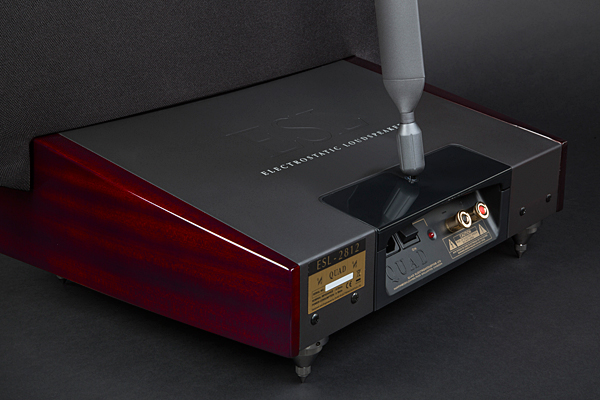
Unpacking and setting up a pair of ESL-2912s is definitely a job for two people—or even four: Two furniture movers helped us get the Quads from the ground level to my second-floor listening room. To give you an idea of what’s involved, the list of “what’s in the box” includes, in addition to the speaker itself, a power cord, four spiked feet, four standard feet, four clamping collars, one collar locking bar, a base stabilizer weight, two securing brackets, screws and shake-proof washers, and, de rigueur for high-end audio components, two pairs of white cotton gloves. On the first page of the owner’s manual are no fewer than 16 warnings, not including “Follow all instructions.”
We first placed the ESL-2912s in the positions in my room that have worked well with a variety of speakers and, with a bit of tweaking, turned out to be good for the Quads. Each ESL-2912 was 41–45″ from the front wall (the distance varied because the speaker tilts back), and its outer edge was about 23″ from the sidewall. I like a wide soundstage, and Derda’s first placements almost did the trick. After he’d left, I moved each speaker about 4″ toward its sidewall, which gave me a wider soundstage with no hole in the middle. With the speakers in these positions, the distance between them, measured from each speaker’s center point, was about 98″, which was also the distance from each center point to my listening seat: an equilateral triangle. The speakers were pointed almost directly at my seat, perhaps just a bit to the side (see photo of my listening room). For serious listening, I routinely lower the blinds, to minimize any reflections that might affect the sound quality. Once I was satisfied with the setup, I installed the ESL-2912s’ spikes.
I’d been told that the review samples had been used at a show, and had also been played at MoFi’s headquarters; nonetheless, their sound benefited from break-in. Over a period of several weeks, playing music as well as various speaker-break-in CDs, I found that the ESL-2912s sounded more open and more dynamic. I also felt that there was some warm-up effect: Before a listening session, the Quads benefited from my playing through them the five-minute “Rejuvenation (rapid refresher)” track from Full System Enhancer & Rejuvenation Disc (CD, IsoTek IBD-CD1).
Which amp?
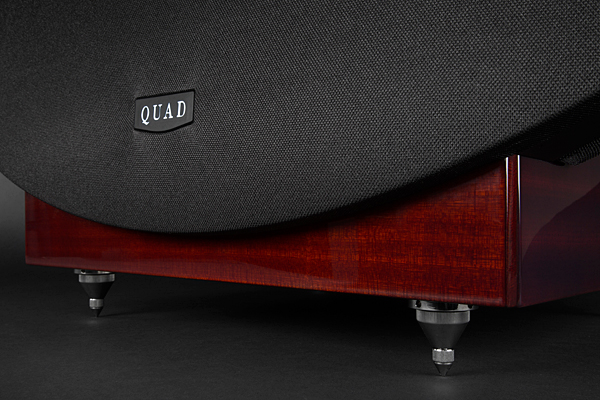 I had on hand two amplifiers to drive the ESL-2912: McIntosh Laboratory’s MC275 LE (tubed, 75Wpc) and Theta Digital’s Prometheus (solid-state, 250Wpc). The McIntosh seemed a natural match—its history goes back to the era of the original Quad ESL. And, indeed, the combination provided a smooth sound that was easy on the ears—but perhaps a little too smooth, and dynamically a bit on the polite side. I tried the MC275’s 8 and 4 ohm terminals; the sound was very slightly better through the 4 ohm taps, so that’s what I used.
I had on hand two amplifiers to drive the ESL-2912: McIntosh Laboratory’s MC275 LE (tubed, 75Wpc) and Theta Digital’s Prometheus (solid-state, 250Wpc). The McIntosh seemed a natural match—its history goes back to the era of the original Quad ESL. And, indeed, the combination provided a smooth sound that was easy on the ears—but perhaps a little too smooth, and dynamically a bit on the polite side. I tried the MC275’s 8 and 4 ohm terminals; the sound was very slightly better through the 4 ohm taps, so that’s what I used.
On paper, the conservatively specified 75Wpc of the MC275 LE is more than enough to drive the Quads, and the 250Wpc of the Theta Prometheus (500Wpc into 4 ohms) might have seemed like overkill. But I’d had good experience with the Prometheus driving Wilson Audio’s Sabrina and Monitor Audio’s PL300 II, and, well . . . it was available. In fact, the combination of ESL-2912s and Prometheus was a good one: more dynamic, more extended and better controlled bass, and, generally, squeaky-clean sound. I can imagine some people preferring the MC275 LE, others the Prometheus; I was quite happy listening through either. My comments about the sound of the ESL-2912 are a kind of averaging of the speaker’s sounds with the two amplifiers.
Sound
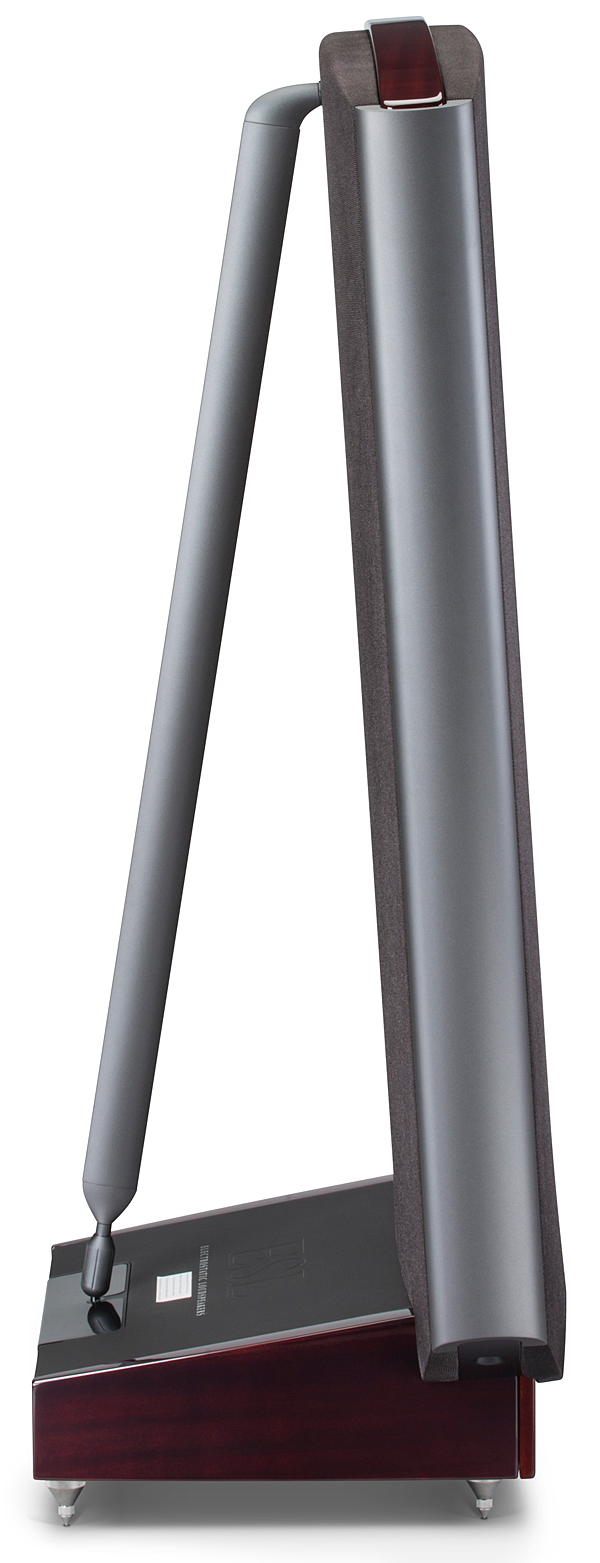
As had been the case with the Quad ESL-63s, my most immediate positive impression of the ESL-2912s was of their presentation of space. Voices and instruments were fixed precisely in space with an almost three-dimensional quality. I’ve heard this type of imaging from other flat-panel electrostatic speakers, including my old KLH Nines, but the trade-off had always seemed to be a very small sweet spot: the head-in-a-vise effect. Some panel speakers—eg, MartinLogan’s Montis—counter this problem with curved panels. This broadens the sweet spot, but the downside is somewhat less precise imaging. The ESL-2912s, presumably because of their circular stators and delay lines, produced precise images over a wider sweet spot. Although the imaging was not quite as good when I sat in a chair next to my central listening seat, instead of collapsing entirely it just shifted to the side.
A speaker with dipole transducers, radiating to the rear as well as to the front, has an easier time filling a room with sound than a unipolar design radiating only to the front. The potential downside is interference with and cancellation of the front radiation by the rearward radiation. I’ve installed no sound-absorbing treatments on my room’s front wall, but the distances between the backs of the ESL-2912s and that wall, and between the speakers and the sidewalls, were well beyond the minimums recommended by Quad. In any case, there was no noticeable front/back interference effect. If there had been, I would have expected it to adversely affect the soundstaging. But the soundstage was wide and deep—depending, of course, on the recording. Listening to the “Depth of Image: Acoustic Clicker” tracks on Best of Chesky Jazz and More Audiophile Tests, Volume 2 (CD, Chesky JD68), I could distinguish depth up to 70′, which is just short of what I can hear with such topnotch unipolar designs as Monitor’s Platinum PL300 IIs.
In view of the history of criticism of the ESL-63, perhaps the most important questions to answer about the ESL-2912 are “Does it go loud?” and “Does it go low?” My answers are “Yes” and “Yes”—with qualifications. The ESL-2912s played loud enough to please me at what I would call realistic levels, but different people have different ideas of what level is appropriate for listening to music. I recently attended a birthday party held in a nightclub, where music was provided by a five-person rock group. I measured the peak level with the trusty Audiotool SPL meter app on my iPhone 6: 103dB (C weighting, fast). I’m pretty sure the ESL-2912s can’t produce that sort of sound level—and I have no problem with that: For me, that’s too loud. (At the party, to protect our hearing, my wife and I balled up Kleenex and stuck it our ears.)
As a check on the ESL-2912’s loudness abilities under more normal conditions, I played Eiji Oue and the Minnesota Orchestra’s recording of Rimsky-Korsakov’s Dance of the Tumblers, from Tutti! An Orchestral Sampler (CD, Reference RR-906CD), at a level that I considered realistic: 92dB peaks, C weighting, fast. The ESL-2912s took this in stride, not protesting in any way, and with no obvious compression of the peaks. Although some audiophiles think of electrostatics as being suitable only for chamber music or music played at background levels, I found the ESL-2912 capable of much more than that.
What about the ESL-2912’s bass response? According to its specs, the two additional bass panels extend the –6dB frequency response to 32Hz, compared to 37Hz for the two–bass-panel ESL-2812. Not having a pair of ESL-2812s on hand, I can’t say how the two models’ bass performances would compare in my room, but I’ve heard the ESL-63 and its various two–bass-panel successors often enough at dealers and shows to say that the ESL-2912 sounded more full-range, and was more capable of producing real bass.
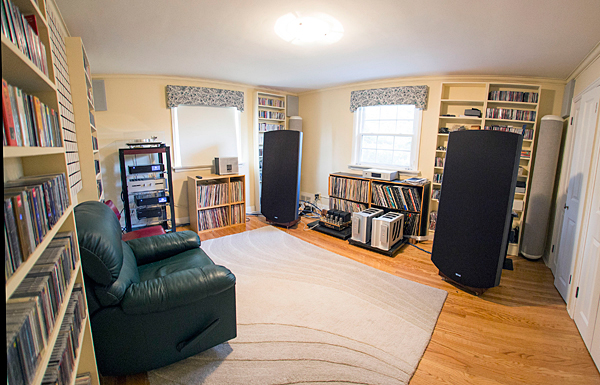
The 32Hz synthesizer note at the beginning of “Temple Caves,” from Mickey Hart’s Planet Drum (CD, Rykodisc RCD 10206), was there—not room-shaking, but a pure bass note, not merely second harmonic masquerading as deep bass. I was able to play this track at peaks of 94dB (C weighting, fast), a level that I feel is about right with this music. Double basses were reproduced with tunefulness and subtle dynamic variations, making me appreciate once again the artistry of bassist David Finck on Sylvia McNair and André Previn’s Sure Thing: The Jerome Kern Songbook (CD, Philips 442 129-2).
But the greatest strength of the Quad ESL series, beginning with the ESL-63 has been, and continues to be, its midrange: smooth, revealing without being over-etched, and presenting a virtual open window on the music. These qualities were particularly revealed by well-recorded voices. One of my 2017 “Records to Die For” was Kristin Chenoweth’s The Art of Elegance (CD, Concord CRE00148), which combines respect for popular-song performance traditions with a fresh take on some standards. Through the ESL-2912 I reveled in the beauty of Chenoweth’s voice and appreciated the subtle nuances of her phrasing. The Quad also excelled at what some refer to as microdynamics, communicating the subtle ebb and flow of the music, orchestral and vocal.
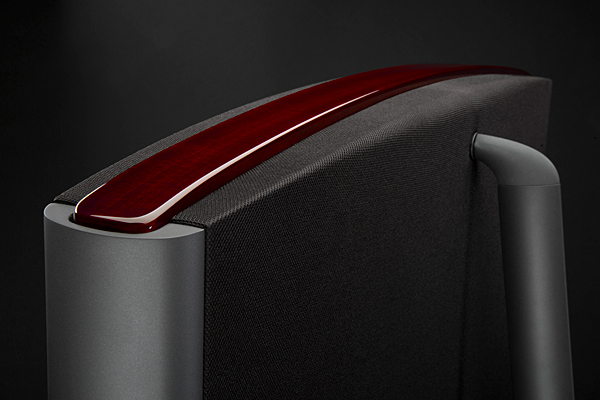
Nonetheless, I heard some departures from strict tonal neutrality, including a midbass emphasis that added to the sound a not-unwelcome warmth. This may have been a function of the speakers’ positions in the room. There was also an attenuation of the extreme highs, most clearly evident with percussion instruments, like the ones in Ana Caram’s “Viola Fora de Moda,” from the Chesky Records Jazz Sampler & Audiophile Test Compact Disc, Vol.1 (CD, Chesky JD37). Monitor Audio’s Platinum PL300 II had a more neutral midbass and more extended treble.
One thing I highly value is a speaker’s ability not to sound like a speaker. The “speaker sound” originates in the drivers, each of which exhibits a set of resonances—and, if the drivers are in an enclosure, the box adds its own resonances, resulting in a “boxy” sound. Over the years, speaker designers have worked hard to solve this problem, with considerable success. Monitor’s Platinum PL300 II, which comprises dynamic drivers in a box, has very little speaker sound, but if you listen very closely, you can hear that it has not been entirely eliminated.
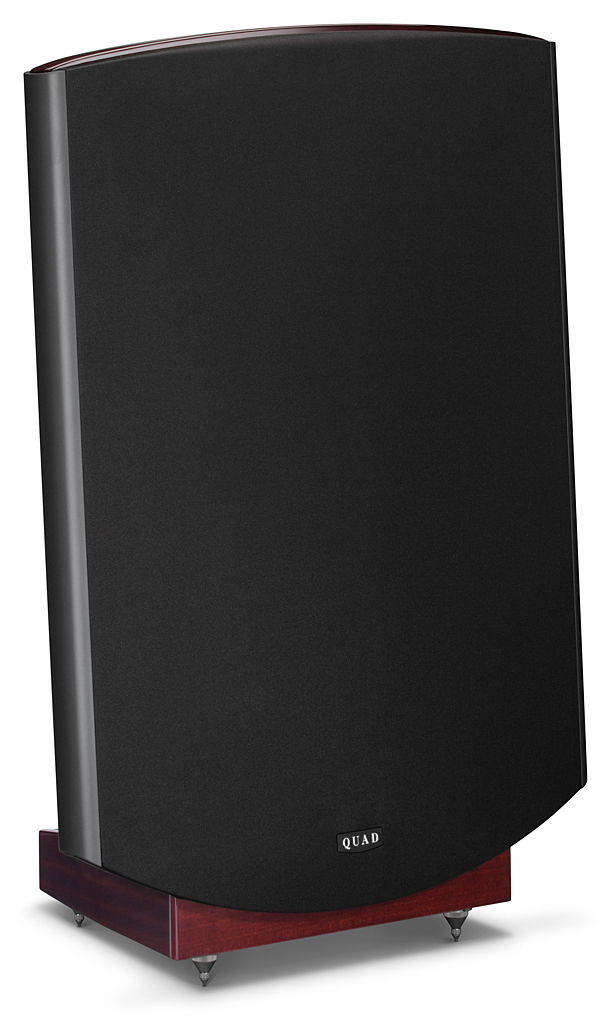
The ESL-2912 has an obvious inherent advantage over box speakers in having no box at all. However, with some music, mostly orchestral, I was at times aware of a kind of drumming sound that wasn’t part of the music. I assumed that this was a characteristic of the stretched polyolefin dustcovers. You’ll recall that removing their dustcovers is one of the ways Quad ESLs have been modified to improve their sound—but this is an extreme step, and unless your listening room is 100% dust free, it will lead to the speaker being damaged in fairly short order. Not recommended!
I think that the resonant colorations that are the source of “speaker sound” are just something that audiophiles and music lovers have to live with, as we concentrate on the music, not the sound. The surprising thing is not that a loudspeaker contributes to the music sounds of its own that are not characteristics of the recording, but that an electromechanical device can manage to sound as much like musical instruments and human voices as it does while adding so little sound of its own.
Conclusions
Peter Walker began work on what was to become the ESL-63 in 1963 (hence the model designation), but the speaker wasn’t launched until 1981. Although Walker died in 2003, production of the ESL line continues, and despite changes and improvements along the way, IAG has remained faithful to Walker’s original concept. The price range of $10,000–$15,000—into which the ESL-2912, at $13,999/pair, squarely falls—may represent the sweet spot (well, at least for high-end audio!) for sound quality and value. With their continuous development of the electrostatic principle, especially in the successful integration of two more bass panels, Quad has maintained its position in this highly competitive market. Peter Walker would be pleased.
Footnote 1: Though the ESL is often referred to as the ESL 57 or ESL-57, “57” was never officially part of that first model’s name.
Footnote 2: See Sam Tellig’s article about Arcici’s Quad stand in the January 1987 issue:.